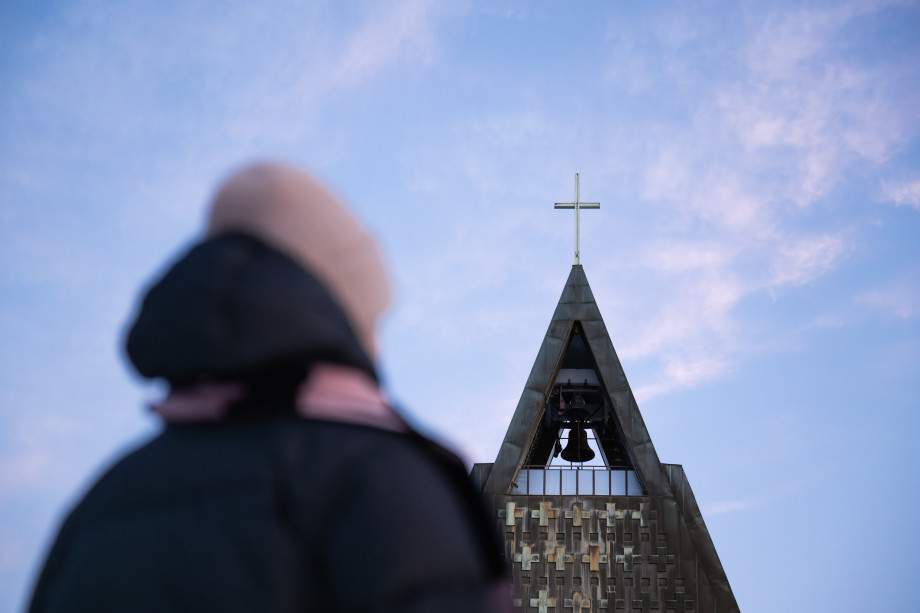- A new report from Barna Research finds that “men are significantly outpacing women in church attendance since the pandemic, reversing a longstanding trend in Barna’s decades of polling. The 2025 gender gap is the largest recorded so far (43 percent for men vs. 36 percent among women).” The Barna poll finds that married fathers have the highest show-up rate at church compared to all other parents, while single mothers significantly trailed married couples in attendance (at 24 percent). For decades, women had outnumbered men in church attendance and often led the way in spiritual interests. But a “significant shift is occurring in American Christianity that demands attention: Women—particularly younger women—are attending church less frequently than men.” Over the years, however, women’s attendance has steadily declined, while men’s has remained more stable. In other words, churches are losing women more than they are gaining men, with the exception of 2025 when male attendance spiked upward. As of 2025, again, 43 percent of men and 36 percent of women report attending church regularly, based on reported weekly attendance. In five of the last six years, men have outpaced women on this key measure of religious engagement, and the 2025 gap is the largest measured.
(The study can be downloaded from: https://stateofthechurch.com/)

-

A recent Pew study finds a significant increase in the share of Americans who say that religion is having more influence in American life. From February 2024 to February 2025, there was a gain of at least 10 percentage points in the proportion of adults, whether Republican or Democrat, and in every age category and most of the large religions, agreeing about religion’s rising influence. Although still a minority viewpoint, the 2025 figure represented 31 percent of the population, up from 18 percent in 2024. This is the highest figure seen in 15 years. The new survey also finds that in recent years a growing share of the public takes a positive view of religion’s role in society. Meanwhile, the share of those saying religion is losing influence fell sharply, from 80 percent in 2024 to 68 percent a year later. In general, 59 percent of U.S. adults express a positive view of religion’s influence on American life. At the same time, the percentage of people who say they feel a conflict between their religious beliefs and mainstream culture is now 58 percent, an increase of 10 percentage points from 2024 and 16 from 2020.
(The study can be downloaded from: https://www.pewresearch.org/religion/2025/10/20/growing-share-of-us-adults-say-religion-is-gaining-influence-in-american-life/)
- The continuing adoption of Christian beliefs among young men in Finland has much to do with the strong countercultural elements of the faith, providing these men with acceptance and a sense of community, according to a study by Kati Tervo-Niemela of the University of Eastern Finland. Tervo-Niemela presented a paper at the early-November meeting of the Society for the Scientific Study of Religion in Minneapolis, which was attended by RW, providing a deeper look at the increasing interest in Christianity among these young men. There have been several journalistic reports and studies showing a slowing down of secularization, particularly among young men, who now outpace young women in church attendance. Finland has been at the vanguard of this trend, and Tervo-Niemela has studied how the religiosity of young male confirmands has grown while young women’s faith has shown slower growth and even decline.

While in 2019 about the same percentage of young men and women believed in God (35 percent), by 2025 a gap had grown, with 67 percent of young men and 56 percent of young women believing. Similar increases and differences between the sexes were seen in belief in Jesus’ resurrection. Tervo-Niemela correlated this increase in religiosity among Finnish young men with a growth in military service. In in-depth interviews with 30 male confirmands, she found that the themes that resonated included: religion addressing personal crisis and search for meaning (80 percent), faith, theology and rituals (67 percent), faith as a counterculture (57 percent), traditions and stability (70 percent), a positive male image during a crisis of masculinity (40 percent), community and safety (73 percent), church as a place for self-development (47 percent), and experiences related to the time of confirmation. Tervo-Niemela points out that while the church more often appeals to those young men who are religious and conservative, the value profile of religious youth is varied, especially among women who are as often liberal as they are conservative.

-
Those churches in Switzerland concerned about competition with secular activities tend to be mainline and Catholic rather than evangelical, and rural rather than urban, according to research by Jorg Stolz of the University of Lausanne. In a paper presented at the early-November meeting of the Society for the Scientific Study of Religion in Minneapolis, which was attended by RW, Stolz said he had expected that more conservative evangelical church leaders would be the ones more concerned about competition for their members’ time from secular sources, as they offer them more programs and alternatives. But it was the more lax mainline and Catholic churches that tended to be more concerned about such secular competition. Using census data on 5,834 religious groups and then surveying 1,395 of them, the researcher also found that, as might be expected, the leaders of declining religious groups were more concerned about secular competition. But, again unexpectedly, the religious leaders of rural congregations were more concerned about secular competition than their urban counterparts.
- Although Eastern Orthodoxy is experiencing net growth, with an increase in families and a more diverse demographic entering the church, the number of new priests being ordained is drastically insufficient to meet current needs and projected growth, according to researchers with the Orthodox Studies Institute (OSI). The researchers, Matthew Namee and Deacon Seraphim Rohlin, were interviewed on October 14 by Fr. Andrew Stephen Damick on his Orthodox podcast. Recent data gathered by the OSI shows that the number of converts has continued to grow, while shifting “from predominantly single young men to young families.” Signs of an increase in Hispanic and black American converts are also reported. Attendance is also increasing in a number of parishes, even during such lean periods as summer. There are variations across jurisdictions, with the more ethnic-oriented ones obviously drawing few converts. If confirmed over the next few years, the growth will also represent a challenge for Orthodox parishes. Even with stable membership, 100 new priests per year would be required. In the most conservative scenario, “the one where we grow by 69 percent over the next 15 years, if we want to just maintain our current parish density, like priest to parishioner ratio, we need to be ordaining about 160 priests per year,” said Deacon Seraphim Rohlin.

The top three American seminaries are producing about 30 new priests annually. Namee and Rohlin suggest potential solutions, such as expanding the role of deacons (following the model of the Antiochian Archdiocese, with those deacons showing the best pastoral abilities then raised to the presbyterate), developing non-residential seminary programs, and adopting a more traditional apprenticeship model for clergy training, similar to the Russian Orthodox Church Outside Russia’s (ROCOR) Pastoral School. This is actually a traditional Orthodox model, as it would involve mentorship and practical experience under experienced priests. The laity should also be encouraged to take on more administrative and community-building roles within parishes to alleviate the burden on clergy and foster a stronger sense of community. Namee and Rohlin add that recent converts should be advised to be mindful of the pastoral load, understanding that priests are not personal therapists and that most issues can wait for regular working hours.
(American Orthodoxy in 2040 podcast, https://www.youtube.com/live/xQ6p3UfSLOA; Orthodox Studies Institute, https://www.orthodoxstudies.org; Orthodox Pastoral School, https://mail.orthodoxtheologicalschool.org/support-the-pastoral-school)
- Due to low fertility, changing age structure, and religious switching, Buddhism remains one of the most rapidly declining religious traditions in the world, according to a study by Yunping Tong and Conrad Hackett of the Pew Research Center. In their Global Religious Landscape study issued last June, Pew found that Buddhists declined by 18.6 million members since 2010, while all of the other world religions showed growth (with Muslims increasing by 346 million members and Christians by 121.6 million). In a paper updating and elucidating the Landscape study, presented at the early-November meeting of the Society for the Scientific Study of Religion, which RW attended, Tong and Hackett explained how the Buddhist decline is mainly being driven by changes in East Asia. For one thing, the general population in the region is older than the global average, and Buddhists in particular are older than the average East Asian. Women in East Asia also have fewer children than the global average, a fertility decline that has impacted Buddhists as well.

The researchers also found that many adults raised as Buddhists in East Asia no longer identify as such, with South Korea and Hong Kong having the lowest rates of those remaining Buddhist (33 and 32 percent, respectively) and the highest rates of switching to other religions or disaffiliating from all religions. In contrast, in Southeast Asia (Cambodia, Thailand, and Sri Lanka), almost all adults who were raised Buddhist still identify with the religion. In general, Buddhists experienced the biggest losses from religious switching, with South Korea leading other countries. Tong and Hackett conclude that while there are newcomers to Buddhism, they won’t be enough to offset the loss from Buddhists switching out of the faith.

- While Shamanism in Korea is often portrayed as a rural remnant of the past that is mainly expressed in Pentecostalism, the religion still has a presence in urban districts of the country, according to researchers. Writing in the journal Religions (October 21), sociologists Jungsun Kim, Yuanfei Li, and Fenggang Yang find that shamanism shows more adaptation to Korean urbanization than decline. The researchers analyzed results from searches of Google Maps and Never Maps revealing 15,639 shamanic sites, as well as religious directories of about 63,000 churches and 15,000 Buddhist temples. They looked at the relationship of these shamanic sites to these other religious groups, aggregating the data to the district level of Korean administration. A density of Protestant churches showed a negative association with shamanic site density. Thus, Protestant expansion reconfigured public space to exclude these shamanist sites (such as through zoning). Buddhist temples and Catholic churches showed less consistent results, although positive local associations were observed for the former. In such regions as the southeast, Buddhist temples have visible authority and formal registration, while “shamanic practice remains domestic, portable, and informal. Kim, Li, and Yang write that Shamanism still exists in urban Korea, but through “strategic ambiguity and informality,” showing considerable vulnerability as it exists without formal institutional recognition and credentialing systems. They conclude that “Korean modernization has not secularized religion uniformly but has redistributed it across differentiated spaces.”
(Religions, https://www.mdpi.com/2077-1444/16/10/1327)







